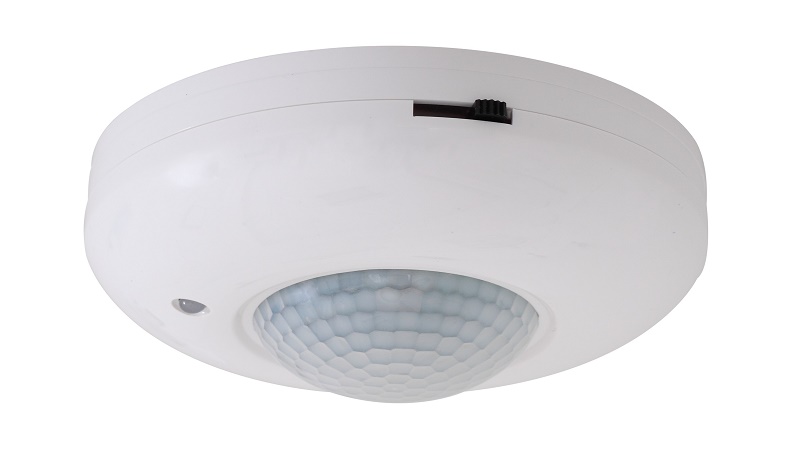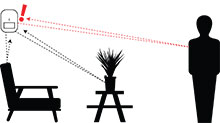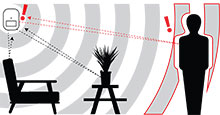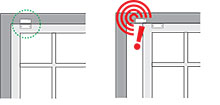
A motion sensor (or motion detector) is the linchpin of your security system, because it's the main device that detects when someone is in your home when they shouldn't be. A motion sensor uses one or multiple technologies to detect movement in an area. If a sensor is tripped, a signal is sent to your security system's control panel, which connects to your monitoring center, alerting you and the monitoring center to a potential threat in your home.
The main purpose of motion detection is to sense an intruder and send an alert to your control panel, which alerts your monitoring center. Sensors work when you are not home, or when you tell the system you are not there. Some security systems can be programmed to record events via a security camera when motion is detected.
Motion sensors stand guard, ready to react to various situations, such as movement in your living room, windows or doors being opened or closed, or a broken window. Motion sensors can:
- Alert you in the event that your teen breaks curfew
- Trigger a doorbell when someone approaches the front door
- Alert you when kids enter restricted areas in the home, like the basement, workout room, or medicine cabinet
- Save energy by using motion sensor lighting in unoccupied spaces
- Notify you if pets enter areas where they're not supposed to be
Passive and Active Motion Sensors
There are two types of motion sensors: passive sensors and active sensors. Each uses different technology to detect motion in the designated area. Passive sensors do not emit energy, but read changes in energy in the surrounding area. Active sensors emit one of three kinds of energy to identify motion in the surrounding area: infrared light, microwave radiation, or sound waves.
 Passive Infrared (PIR)
Passive Infrared (PIR)
Detects body heat (infrared energy). Passive infrared sensors are the most widely used motion in home security systems. When your system is armed, your motion sensors are activated. Once the sensor warms up, it can detect heat and movement in the surrounding areas, creating a protective "grid." If a moving object blocks too many grid zones and the infrared energy levels change rapidly, the sensors are tripped.
 MircoWave (MW)
MircoWave (MW)
Sends out microwave pulses and measures the reflection off a moving object. They cover a larger area than infrared sensors, but they are vulnerable to electrical interference and are more expensive.
 Dual Technology Motion Sensors
Dual Technology Motion Sensors
Motion sensors can have combined features in an attempt to reduce false alarms. For example, a passive infrared (PIR) sensor could be combined with a microwave sensor. Since each operates in different areas of the spectrum, and one is passive and one is active, Dual Technology motion sensors are not as likely as other types to cause false alarms, because in order for the alarm to be triggered, both sensors have to be tripped. However, this does not mean that they never cause false alarms.
Area Reflective Type
Emits infrared rays from an LED. Using the reflection of those rays, the sensor measures the distance to the person or object and detects if the object is within the designated area.
Ultrasonic
Sends out pulses of ultrasonic waves and measures the reflection off a moving object.
Vibration
Detects vibration. These can be purchased or easily made at home. A homemade vibration sensor uses a small mass on a lever, which is activated by a switch to an alarm when it vibrates. Homemade motion sensors can work, but they can also be unreliable.
Other Motion Sensor Features
Wireless Motion Sensors
Today, most motion sensors are wireless. Wireless sensors are very easy to set up. They do not require drilling, and they communicate with the other security system components wireless.
 Contact Motion Sensors (door/window)
Contact Motion Sensors (door/window)
Most contact motion sensors are passive infrared sensors. They trigger an alarm if the protected door or window is opened while the system is armed.
 Pet Immune Motion Sensors
Pet Immune Motion Sensors
A passive infrared sensor can be set up to ignore animals up to a certain weight. A dual technology motion sensor is more resistant to false alarms caused by animals because it requires two sensors to be triggered in a manner determined by the manufacturer. They can be set up to ignore a large animal or multiple small animals without setting off a false alarm. Some pet immune motion sensors have a sensitivity level that can be adjusted for families with very active animals.